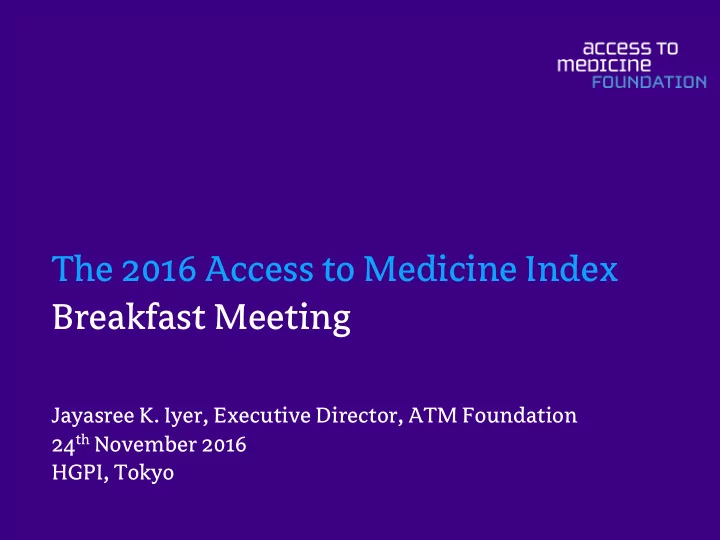

The 2016 Access to Medicine Index Breakfast Meeting Jayasree K. Iyer, Executive Director, ATM Foundation 24 th November 2016 HGPI, Tokyo
5 billion people have access to medicine 2 billion to go Acceptability Accessibility Affordability Availability
The Access to Medicine Foundation Research on, and incentives for, pharmaceutical • companies and access to medicine Independent, non-profit organisation • Multi-stakeholder approach •
Our model for change Build consensus Bu on what to expect from the industry and where incentives and disincentives exist. St Stim imula ulate a a “rac ace to do do well” ll” in key access-to-medicine areas, by creating competition on targets and topics. Di Diffu fuse best practices to share information and new insights into the best approaches for driving change.
What we do
60 investors – AUM in excess of USD 5.5 trillion
2016 Access to Medicine Index What we measure
Framework for analysis
Company scope AbbVie Inc. GlaxoSmithKline plc Astellas Pharma Inc. Johnson & Johnson AstraZeneca plc Merck & Co. Inc. Bayer AG Merck KGaA Boehringer Ingelheim Novartis AG GmbH Novo Nordisk A/S Bristol-Myers Squibb Co. Pfizer Inc. Daiichi Sankyo Co. Ltd. Roche Holding AG Eisai Co. Ltd. Sanofi Eli Lilly & Co. Takeda Pharmaceutical Gilead Sciences Inc. Co. Ltd.
Geographic scope
Disease scope
2016 Access to Medicine Index Report Highlights
A comprehensive report
2016 Access to Medicine Index Key Finding: R&D
Leaders in R&D address needs and ensure access for people living in low- and middle-income countries
Efforts to meet product R&D needs are uneven
Efforts to meet product R&D needs are uneven
Over one third of product gaps with Over one third of product gaps with low commercial incentive being low commercial incentive being addressed addressed
Over one third of product gaps with Over one third of product gaps with low commercial incentive being low commercial incentive being addressed addressed
Collaborative research models appear effective in engaging the industry in developing urgently needed products with low commercial potential
Seven companies have the strongest focus on high-priority product gaps with low commercial incentive
Only a few commercially-promising projects have plans for access in place
Access provisions are set earlier when projects are conducted in partnership
2016 Access to Medicine Index Key Finding: Capacity Building
Leading companies systematically address local needs
Leading companies systematically address local needs
2016 Access to Medicine Index Key Finding: Business Models
Commercial business models address lower income populations
Commercial business models address lower income populations
2016 Access to Medicine Index Key Finding: Product Deployment
True needs-based pricing is limited
Leaders take multiple socio-economic factors into account when pricing their products
Licensing expands but excludes key middle-income countries
Large emerging markets are often overlooked in voluntary licensing agreements
2016 Access to Medicine Index Performance of Japanese Companies
Eisai Co., Ltd. • Strong in Market Influence & Compliance • Highest proportion of R&D through partnerships, notably NTDs • Commits to not enforcing patents in certain low-and middle income countries • Donates to eliminate Lymphatic Filariasis
Takeda Co., Ltd. • New access strategy launched • R&D in NTDs (leishmaniasis, Chagas), dengue and norovirus • Commits to not enforcing patents in Sub-Saharan Africa
Daiichi Sankyo Co., Ltd. • Pipeline increased 50% for multiple discovery projects • Commits to reporting falsified medicine to national authorities • Supports mobile health clinics, access to medical services • Technology transfer of vaccines in India, Cameroon and Tanzania
Astellas Pharma Inc. • R&D in neglected diseases such as schistosomiasis and Chagas disease • Strengthens supply chain management in China and South East Asia • Commits to building manufacturing capacity in Brazil and Iran
Q & A
Thank you jiyer@atmindex.org www.accesstomedicineindex.org
Recommend
More recommend